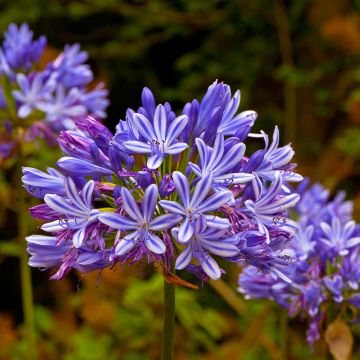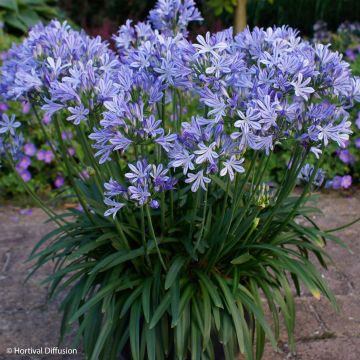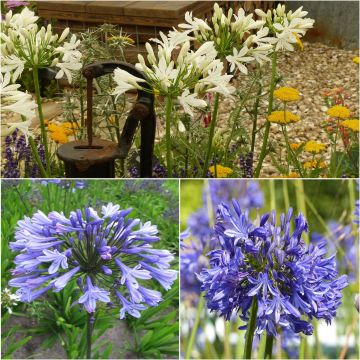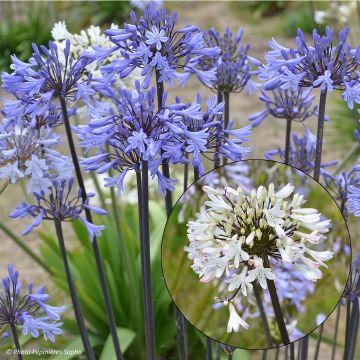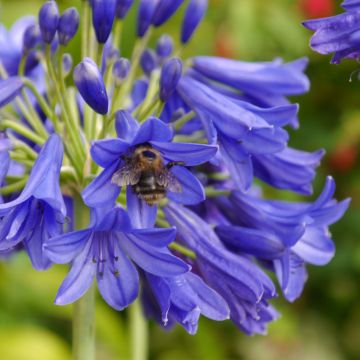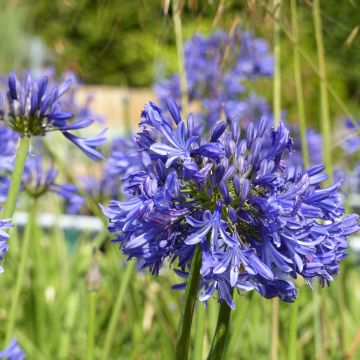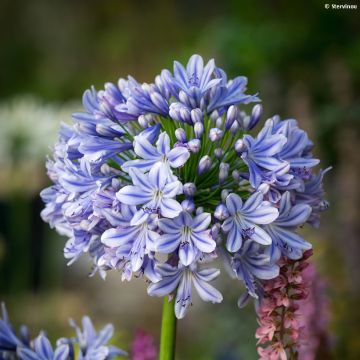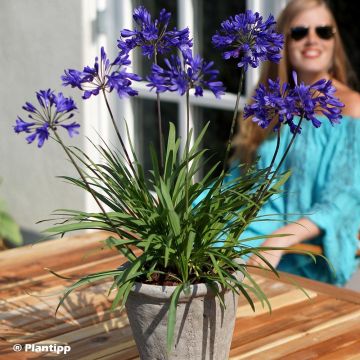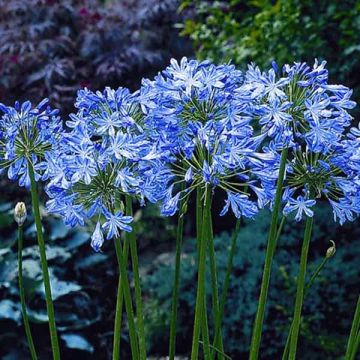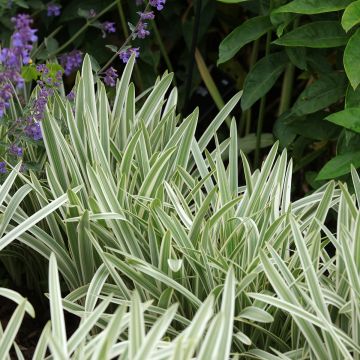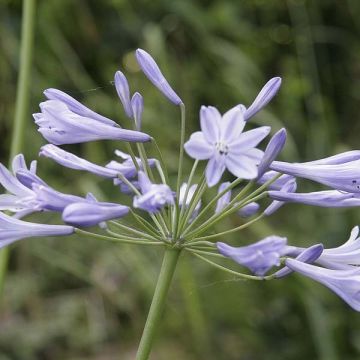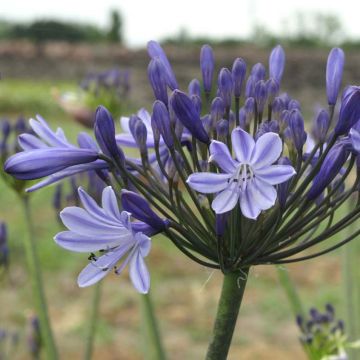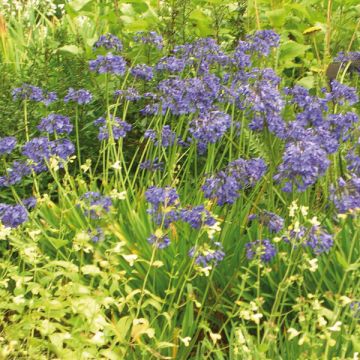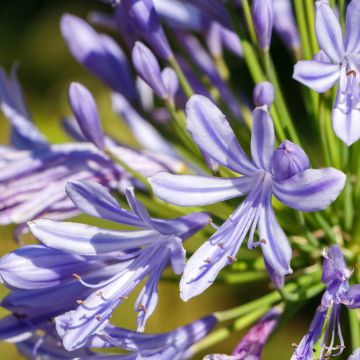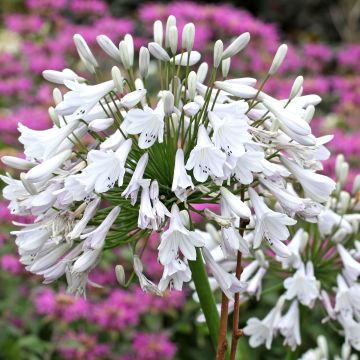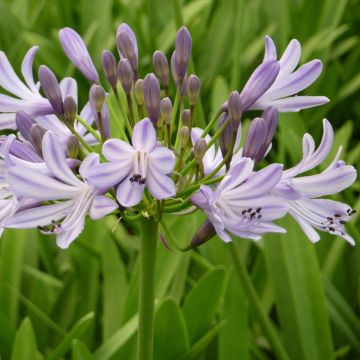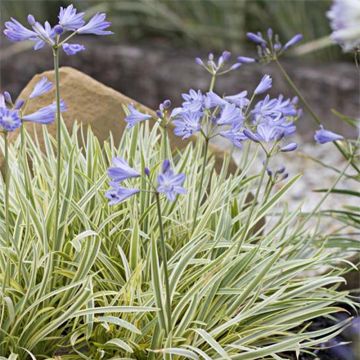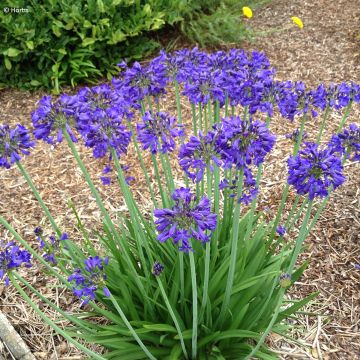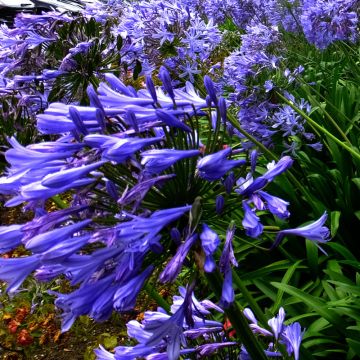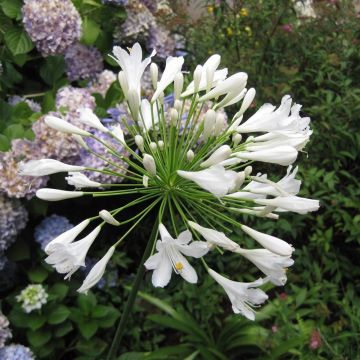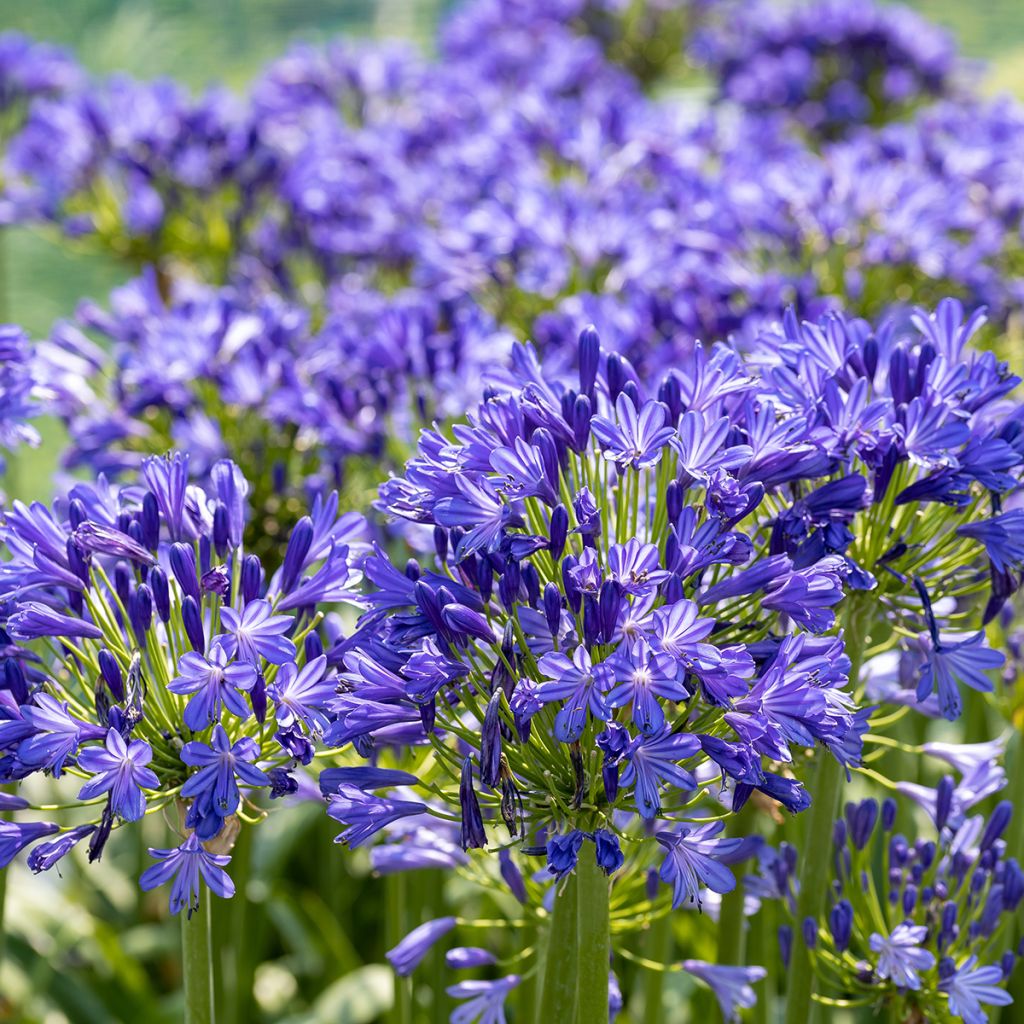

Agapanthus 'Blue Velvet'
Agapanthus 'Blue Velvet'
Agapanthus Blue Velvet
African Lily, Lily of the Nile
Why not try an alternative variety in stock?
View all →This plant carries a 12 months recovery warranty
More information
We guarantee the quality of our plants for a full growing cycle, and will replace at our expense any plant that fails to recover under normal climatic and planting conditions.
From €5.90 for pickup delivery and €6.90 for home delivery
Express home delivery from €8.90.
From €5.90 for pickup delivery and €6.90 for home delivery
Express home delivery from €8.90.
Does this plant fit my garden?
Set up your Plantfit profile →
Description
The Agapanthus 'Blue Velvet' is a variety of agapanthus with semi-evergreen foliage, hardy down to approximately -10°C. It produces beautiful umbels of tubular blue-violet flowers from very dark buds. Each petal is crossed by a more intense central band for added character. The flowers bloom from July to September on a cascading clump of lush foliage. It is ideal for mass planting in the garden. It thrives in full sun, in ordinary but well-drained soil, not too dry in summer.
Agapanthus are plants from the lily family native to South Africa. Horticulturists have extensively hybridised several species for new colours, more compact and hardier plants, and better adaptation to our climates. The cultivar 'Blue Velvet' is a descendant of Agapanthus praecox subsp. Orientalis. This plant develops and multiplies rapidly from a stump with fleshy rhizomes, forming a dense clump of dark green and shiny linear foliage with a minimum diameter of 60 cm, spreading over time. The flowering takes place in midsummer. Strong stems averaging 90 cm in height emerge from the foliage clump. They bear hemispherical umbels measuring 10-12 cm in diameter, composed of numerous small campanulate flowers. Each flower has six deep blue-violet-coloured petals crossed by a darker central line. Long peduncles carry them. The foliage is semi-evergreen in not-too-cold climates.
The 'Blue Velvet' Agapanthus combines elegance and character with fairly good hardiness. It adapts easily to many regions, primarily if a thick winter mulch protects its stump. It is particularly suitable for mild coastal climates. Plant 'Blue Velvet' in borders, edges or large rockeries, combined with other mauve, blue or white varieties in a contemporary setting. Its exotic appearance also makes it a good companion in contrast with warm-coloured blooms, such as Kniphofias, Daylilies, medium-height ornamental grasses, and Cannas.
Report an error about the product description
Flowering
Foliage
Plant habit
Botanical data
Agapanthus
Blue Velvet
Alliaceae - Liliaceae
African Lily, Lily of the Nile
Cultivar or hybrid
Other Agapanthus - Lily of the Nile
Planting and care
Plant Agapanthus by covering them with at least 10 cm of good soil to be more resistant to the cold. It is essential to plant them in spring and preferable to mulch them in winter in most regions. Use five young plants for a 24 cm pot for pot cultivation and shelter your pots in winter. They prefer a rich and moist but well-drained soil enriched with sand. Water them regularly during the growth period (twice a week). However, avoid watering them afterwards. They are sensitive to excess moisture in winter. This hardy variety can withstand temperatures down to approximately -12°C and thrives particularly well in borders and containers. Use a well-drained sandy mix that is slightly acidic. This plant prefers shallow but wide containers and will flower abundantly if regularly fed with a slow-release fertiliser.
Planting period
Intended location
Care
This item has not been reviewed yet - be the first to leave a review about it.
Haven't found what you were looking for?
Hardiness is the lowest winter temperature a plant can endure without suffering serious damage or even dying. However, hardiness is affected by location (a sheltered area, such as a patio), protection (winter cover) and soil type (hardiness is improved by well-drained soil).

Photo Sharing Terms & Conditions
In order to encourage gardeners to interact and share their experiences, Promesse de fleurs offers various media enabling content to be uploaded onto its Site - in particular via the ‘Photo sharing’ module.
The User agrees to refrain from:
- Posting any content that is illegal, prejudicial, insulting, racist, inciteful to hatred, revisionist, contrary to public decency, that infringes on privacy or on the privacy rights of third parties, in particular the publicity rights of persons and goods, intellectual property rights, or the right to privacy.
- Submitting content on behalf of a third party;
- Impersonate the identity of a third party and/or publish any personal information about a third party;
In general, the User undertakes to refrain from any unethical behaviour.
All Content (in particular text, comments, files, images, photos, videos, creative works, etc.), which may be subject to property or intellectual property rights, image or other private rights, shall remain the property of the User, subject to the limited rights granted by the terms of the licence granted by Promesse de fleurs as stated below. Users are at liberty to publish or not to publish such Content on the Site, notably via the ‘Photo Sharing’ facility, and accept that this Content shall be made public and freely accessible, notably on the Internet.
Users further acknowledge, undertake to have ,and guarantee that they hold all necessary rights and permissions to publish such material on the Site, in particular with regard to the legislation in force pertaining to any privacy, property, intellectual property, image, or contractual rights, or rights of any other nature. By publishing such Content on the Site, Users acknowledge accepting full liability as publishers of the Content within the meaning of the law, and grant Promesse de fleurs, free of charge, an inclusive, worldwide licence for the said Content for the entire duration of its publication, including all reproduction, representation, up/downloading, displaying, performing, transmission, and storage rights.
Users also grant permission for their name to be linked to the Content and accept that this link may not always be made available.
By engaging in posting material, Users consent to their Content becoming automatically accessible on the Internet, in particular on other sites and/or blogs and/or web pages of the Promesse de fleurs site, including in particular social pages and the Promesse de fleurs catalogue.
Users may secure the removal of entrusted content free of charge by issuing a simple request via our contact form.
The flowering period indicated on our website applies to countries and regions located in USDA zone 8 (France, the United Kingdom, Ireland, the Netherlands, etc.)
It will vary according to where you live:
- In zones 9 to 10 (Italy, Spain, Greece, etc.), flowering will occur about 2 to 4 weeks earlier.
- In zones 6 to 7 (Germany, Poland, Slovenia, and lower mountainous regions), flowering will be delayed by 2 to 3 weeks.
- In zone 5 (Central Europe, Scandinavia), blooming will be delayed by 3 to 5 weeks.
In temperate climates, pruning of spring-flowering shrubs (forsythia, spireas, etc.) should be done just after flowering.
Pruning of summer-flowering shrubs (Indian Lilac, Perovskia, etc.) can be done in winter or spring.
In cold regions as well as with frost-sensitive plants, avoid pruning too early when severe frosts may still occur.
The planting period indicated on our website applies to countries and regions located in USDA zone 8 (France, United Kingdom, Ireland, Netherlands).
It will vary according to where you live:
- In Mediterranean zones (Marseille, Madrid, Milan, etc.), autumn and winter are the best planting periods.
- In continental zones (Strasbourg, Munich, Vienna, etc.), delay planting by 2 to 3 weeks in spring and bring it forward by 2 to 4 weeks in autumn.
- In mountainous regions (the Alps, Pyrenees, Carpathians, etc.), it is best to plant in late spring (May-June) or late summer (August-September).
The harvesting period indicated on our website applies to countries and regions in USDA zone 8 (France, England, Ireland, the Netherlands).
In colder areas (Scandinavia, Poland, Austria...) fruit and vegetable harvests are likely to be delayed by 3-4 weeks.
In warmer areas (Italy, Spain, Greece, etc.), harvesting will probably take place earlier, depending on weather conditions.
The sowing periods indicated on our website apply to countries and regions within USDA Zone 8 (France, UK, Ireland, Netherlands).
In colder areas (Scandinavia, Poland, Austria...), delay any outdoor sowing by 3-4 weeks, or sow under glass.
In warmer climes (Italy, Spain, Greece, etc.), bring outdoor sowing forward by a few weeks.

































